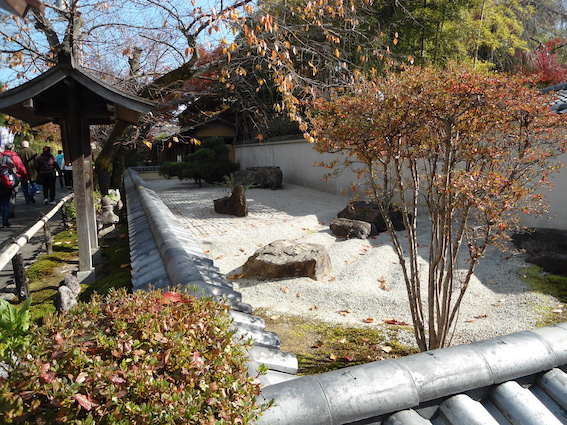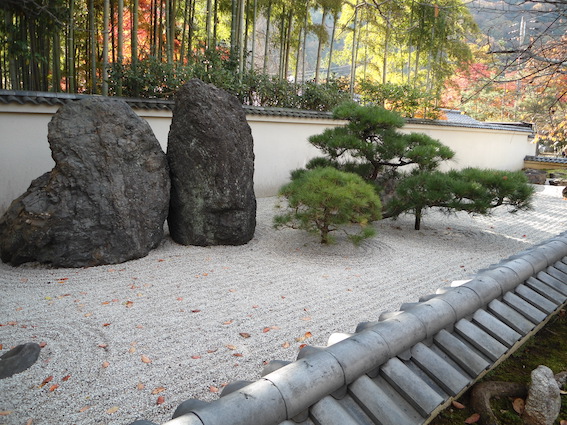Whilst in Japan, I had the opportunity to visit several exquisite gardens. Japanese gardens have been influenced by the Shinto love of nature and the Buddhist idea of paradise. Most gardens appear to share a common aim of creating a microcosm. Elements such as water, stones, moss and trees are combined to form an idealised and symbolic miniature landscape. By emphasising certain plants and rocks and through careful choice and arrangement, contrasts can be drawn between little and large, rough and smooth, fragility and strength, etc.
Dry-landscape gardens, often called Zen Gardens, are designed to be viewed from a single point or side. Zen gardens express harmony between humanity and nature. Some are designed to be symbolic. Others are purely abstract with the sole function of inviting meditation. They can be a place to discover the source and strength of humanity and to awaken our spirituality. They are sometimes called “Gardens of the Mind” or referred to as kare-sansui (withered landscapes).
I was particularly pleased to stumble across this garden which has many classic elements and is meticulously maintained. Most dry-landscape gardens, being an aid to meditation are found near or attached to Buddhist temples. They aim to help you meditate about the true meaning of life. Documents about rock gardens have been found dating back to the 9th Century but Zen Gardens really began to be developed during the Muromachi Period (1336-1573) which happened around the same time as the Renaissance.

The garden is one which can be viewed from one side and the changes within the garden reflect this. The plain background wall enhances the abstract arrangement. The simplicity (and yet subtle complexity and symbolism) of the garden does make viewing easy on the eye. There is less visual clutter. Zen gardens are usually small compared to the bigger expanses of a strolling garden which is designed to be walked through.

If you look carefully, the raked gravel changes through the length of the garden. This usually symbolises water. At the end with the small rocks, the gravel forms large waves. The white colour of the gravel represents white space, emptiness or distance in Buddhism. In the Shinto religion, white is about purity. Some Zen Gardens have gravel raked into cone-shaped mounds which mimic Mount Fuji. Rivers of gravel can represent metaphorical journeys through life. The raking of gravel can help with concentration and is regarded as an aesthetic experience. The gravel patterns are not static and can be changed.

The flat rocks are sometimes regarded as specific mediation rocks which are believed to radiate calm and silence. The choice and placement of rocks matters hugely. For example, igneous rocks might be used when creating mountains. Sedimentary rocks may be chosen to line a river. Unusual shapes of rocks may be a key feature. The grain of rocks may all need to run in a particular direction. Brightly coloured rocks are often avoided, for fear of distracting the viewer from the overall effect. The siting of random rocks can represent spontaneity. The placement of rocks is rarely symmetrical. Usually there is a balance between the numbers of vertically and horizontally placed rocks.

When creating a dry-landscape garden, spontaneity and experimentation are part of the process. It can be a metaphor for our lives and creating calm within it. When introducing children to Zen Gardens, several bloggers have written about small-scale Zen Gardens that they have undertaken with pre-school aged children using sandpits and trays. This can be a useful planning process with older children too, for exploring the properties of sand, gravel and the elements. Have a look at this post from The Magic Onion
For technical advice and more information, you may wish to buy one of many books available about Japanese Gardens which can be found online or doing an image search for “Japanese Gardens” will also provide some beautiful, inspiring images. This example from a Czech nursery shows that we can create simple structures which can allow children to think and experiment through play-based experiences.

Visit a builder’s merchant or local building store to find out what types of rock and gravel exist. It could be that you wish to have a selection of colours available. Again, encourage children to think about colours which aid thinking and reflection rather than detract from it. It is also worth thinking about the use of local stone from nearby quarries so that your zen garden reflects local landscape.

For me, the concept and design of Zen Garden is a perfect fusion of religion, nature and humanity. Several questions that spring to mind when looking at and planning a garden include:
- Is viewing this garden a prompt to opening my mind and viewing life from a different perspective?
- Does the isolation of the natural elements stimulate a response from my soul?
- For even a brief moment, does the universe feel a simpler place to exist?
I would love to know if you have experimented with Zen Gardens on either a small or large scale and how children responded in your establishment.
This blog post was originally published in January 2013.






























Wonderfully informative article. We had a Buddhist Faith Day at our school last month. On Faith Days, the year groups throughout the school are mixed up and siblings are grouped together. The children then move around the different classrooms throughout the day doing a range of activities linked to a particular faith. In our class we made miniature zen gardens from raked sand, river pebbles and succulent plants. The children were very good at interpreting what the different elements of the garden represented. The plan is to have a miniature zen garden in each classroom for the children to use during contemplation time. We introduced Buddhism and the concept of meditation to the children by sharing a clip from the film ‘Kung Fu Panda’ and quote from Master Oogway, Yesterday is history, tomorrow is a mystery, but today is a gift. That is why it is called the “present”, We laid cushions and blankets on the floor lit candles and listened a meditative story. It was a lovely calm day and I was surprised how receptive the children were to meditating.
Thanks for such interesting accounts – I really like the idea of Faith Days. In my experience, children do respond to meditation activities, even rowdier classes. One of the nicest ones I’ve seen was getting children to really look, smell and feel a satsuma before slowly eating it. Very multi-sensory.
I would love to visit some authentic Japanese gardens, so glad you decided to share what you learnt on your trip! I think what you said about the world begin a simpler place for a few moments is really interesting. I have a miniature zen garden on my desk, and its amazing how swirling a few patterns in the sand can provides a true moment of clarity in what is otherwise a stressful, demanding environment for the most part.